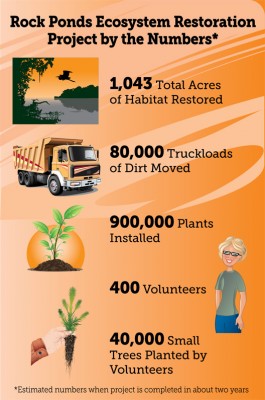Dozens of state and community leaders joined the District last week in kicking off the Rock Ponds Ecosystem Restoration Project.
The project, located just north of the Manatee County line in Ruskin, will feature more than 1,000 acres of restored

uplands and wetlands when completed in about two years. Executive Director Robert Beltran acknowledged the project was possible thanks to community partners like Hillsborough County.
“Over the years, Hillsborough County has been an incredible partner as we’ve worked together to restore coastal habitats along Tampa Bay,” he said.
Florida Department of Environmental Protection Secretary Herschel Vinyard agreed.
“Nothing gets done unless you have partners,” he said.
About 381 acres will be restored as coastal uplands and 398 acres will be restored as various freshwater and estuarine wetlands. This project is adjacent to and will compliment 264 acres of previously restored upland habitats on the site.
Restoration of these communities will help offset habitat losses suffered throughout Tampa Bay and will prove valuable for the public and the thousands of coastal species that live within the Tampa Bay ecosystem.
The project will require moving 80,000 truckloads of dirt and installing 900,000 plants.
“We’re working with Tampa Bay Watch to organize the largest volunteer marsh planting ever conducted in the history of Tampa Bay,” Beltran said. “We hope to have 400 volunteers plant 40,000 sprigs in one day.”

Governing Board Chair Carlos Beruff and board member Wendy Griffin helped commemorate the event by leading a planting of a small longleaf pine.
The Rock Ponds project, part of the District’s Surface Water Improvement and Management (SWIM) Program, is lead by Brandt Henningsen, chief environmental scientist and Nancy Norton, professional engineer. The SWIM Program, along with its partners, has completed more than 90 restoration projects along Tampa Bay involving more than 4,500 acres of habitats. To learn more about SWIM, visit WaterMatters.org/SWIM.
